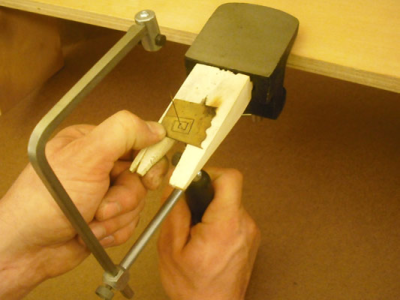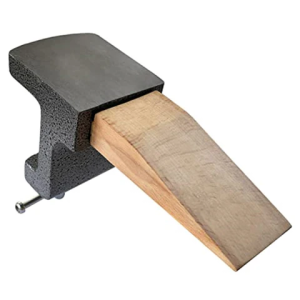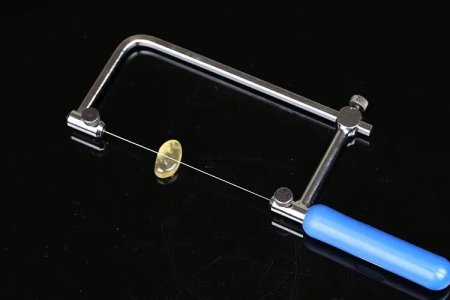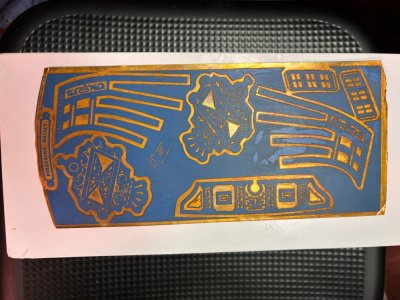I have to cut out some parts from this copper sheet provided in the HMS Peregrine kit. The piece is 11/64 inch thickness. Metal snips won't work due to the intricate pattern. Is there any recommended tools that would work?
-

Win a Free Custom Engraved Brass Coin!!!
As a way to introduce our brass coins to the community, we will raffle off a free coin during the month of August. Follow link ABOVE for instructions for entering.
You are using an out of date browser. It may not display this or other websites correctly.
You should upgrade or use an alternative browser.
You should upgrade or use an alternative browser.
wow, that is just short of 3/16 thick. Probably your best bet would be a scroll saw (hand held style, not the power tool, if the part is that intricate) and then file the edge smooth with micro files.
Can we see the plans for what you have to make?
It cannot be 0.1718" (11/64") sheet. 1/64" (0.015") is more like it.This is the sheet. It's from the Peregrine Galley by Sergal.
Now that I see it, I agree with you. I still say the jewelers/scroll saw and smooth it with files.It cannot be 0.1718" (11/64") sheet. 1/64" (0.015") is more like it.
Just as an FYI, keep in mind that the Peregrine Galley was circa 1700 and the British did not allow names on any of their warships vessels until 1771, and then only for ten years when they were banned once again. Your model, your call.  When names were allowed they were painted at least 12 inches high and not in a frame.
When names were allowed they were painted at least 12 inches high and not in a frame.
I realize when people look at the model, they may wonder the name, but you can always put it on the display stand.
Allan
I realize when people look at the model, they may wonder the name, but you can always put it on the display stand.
Allan
- Joined
- Jun 29, 2024
- Messages
- 1,280
- Points
- 393

I agree, jeweler’s saw and files.
Try a sharp Xacto blade.
- Joined
- Jun 29, 2024
- Messages
- 1,280
- Points
- 393

Assuming that it’s only 1/64” thick metal snips or better yet scissors should cut it easily. Cut it as close as you can and then file to shape.
Copper is so soft that it’s rather “gummy” so you want to rough out the shape first with a rather coarse file. You will also need a wire brush to clean the file.
Roger
Copper is so soft that it’s rather “gummy” so you want to rough out the shape first with a rather coarse file. You will also need a wire brush to clean the file.
Roger
There's a tool made for the job. It is the "jeweler's" or "piercing" saw. It's quite amazing how few ship modelers are familiar with the existence, let alone the proper use of this essential metal working tool. Books have been written on how to use a jeweler's saw.
It must be used with a jeweler's "bench peg" and selecting the proper blade for the metal to be sawed is important. There is a specific technique to using one. If that technique is learned, they are surprisingly accurate on very small work and very efficient. If you just start sawing, you'll break a lot of blades, develop carpal tunnel syndrome, not cut much, and not be a happy camper. Take the time to master this essential modeling tool.
There are many instructional videos on how to use a jeweler's or piercing saw. You almost certainly won't get one to work well for you unless you watch a few of these tutorials. See: https://www.youtube.com/results?search_query=How+to+use+a+jewelers+saw?
Using a jeweler's saw and bench peg:

Bench peg with integral anvil surface... the finestkind in my opinion. About $20: https://www.amazon.com/Bench-Jewele...4d33378bca00ecf5801aa5&qid=1761279088&sr=8-53

It must be used with a jeweler's "bench peg" and selecting the proper blade for the metal to be sawed is important. There is a specific technique to using one. If that technique is learned, they are surprisingly accurate on very small work and very efficient. If you just start sawing, you'll break a lot of blades, develop carpal tunnel syndrome, not cut much, and not be a happy camper. Take the time to master this essential modeling tool.
There are many instructional videos on how to use a jeweler's or piercing saw. You almost certainly won't get one to work well for you unless you watch a few of these tutorials. See: https://www.youtube.com/results?search_query=How+to+use+a+jewelers+saw?
Using a jeweler's saw and bench peg:

Bench peg with integral anvil surface... the finestkind in my opinion. About $20: https://www.amazon.com/Bench-Jewele...4d33378bca00ecf5801aa5&qid=1761279088&sr=8-53

I just got back from a trip to a jewelry-maker supply store in downtown Tokyo. Among many other things, they must have had 20-30 models of these saws, as well as bench pegs and even benches. The second floor was 3D printers and CNC laser cutters. I could go broke in there.There's a tool made for the job. It is the "jeweler's" or "piercing" saw. It's quite amazing how few ship modelers are familiar with the existence, let alone the proper use of this essential metal working tool. Books have been written on how to use a jeweler's saw.
It must be used with a jeweler's "bench peg" and selecting the proper blade for the metal to be sawed is important. There is a specific technique to using one. If that technique is learned, they are surprisingly accurate on very small work and very efficient. If you just start sawing, you'll break a lot of blades, develop carpal tunnel syndrome, not cut much, and not be a happy camper. Take the time to master this essential modeling tool.
There are many instructional videos on how to use a jeweler's or piercing saw. You almost certainly won't get one to work well for you unless you watch a few of these tutorials. See: https://www.youtube.com/results?search_query=How+to+use+a+jewelers+saw?
Using a jeweler's saw and bench peg:
View attachment 552290
Bench peg with integral anvil surface... the finestkind in my opinion. About $20: https://www.amazon.com/Bench-Jewelers-Jewelry-Making-Workbench/dp/B07KGJBP7C/ref=sr_1_53?adgrpid=1335907194954613&dib=eyJ2IjoiMSJ9._JnCXgc8qFzIeCBBaDujd5L_1HNfiADt-p6t7tfWzIKIf6gJ7u6rl1uTGf8V93FNqUsHFAB3OOdIPw04wiFDhPjVkjGX_VNL0lmM0fPbP52dY0n5n3DUEEZWOm2RjX46j-I3n-GrD0BQRpVNxuBHwXrXiEvViBKH9P9hlnBACqMcL6Ztk1NSbRsc6C5K6xJkp7ygGd5pitn1vjmEmMANvzdbTg4yeK6MkqSBe26-BQ_BnhrG_y29LpdjbKXt_yasANBxIYnLr0NRpz1Y-bJ228SSAqr5MFe8oYr62Y3GEWc.XCmHe9MGkNYMQPo9ehvYP9Bx1FsBd9tEzQY5TJJTiaY&dib_tag=se&hvadid=83494522325559&hvbmt=be&hvdev=c&hvlocphy=88716&hvnetw=o&hvqmt=e&hvtargid=kwd-83494553893906:loc-190&hydadcr=29812_14608281&keywords=bench+block+anvil&mcid=4c021561034d33378bca00ecf5801aa5&qid=1761279088&sr=8-53
View attachment 552291
... Among many other things, they must have had 20-30 models of these saws, as well as bench pegs and even benches. The second floor was 3D printers and CNC laser cutters. I could go broke in there.
Indeed, yet with an investment of a relatively mere pittance, one can acquire a few hand tools and the skills to use them at no cost at all and accomplish the same results with exponentially greater personal gratification. Similarly, one can take a photograph with an expensive digital camera and print it with an expensive color printer, or with diligently acquired personal skill depict the same scene on canvas with brushes, and a few tubes of oil paint. Which picture is the more worthwhile expression of one's soul? Which result is more worthy of being called "art," and its maker called an "artist?" And if such be one's motivation, for which will a buyer pay more to purchase?
- Joined
- Nov 2, 2021
- Messages
- 32
- Points
- 58

Wow, that's a bit deep.
Use a piercing saw and fine blade or some sharp snips, finish off with Swiss files. Care and skill req.
Doug Hey NZ
Use a piercing saw and fine blade or some sharp snips, finish off with Swiss files. Care and skill req.
Doug Hey NZ
I agree, a jeweler's saw and bench peg followed by a series of increasingly finer small files works quite well for significantly thicker brass. If you want to spend on more than a saw and a bench peg to make even better pieces from metal, invest in quality files of different ratings, they do wonders. It's the way a jeweler would tell you to do it. But the saw, peg, and standard file will get you through this project.
- Joined
- Jun 29, 2024
- Messages
- 1,280
- Points
- 393

A set of needle files (usually 12 per set) should be one of the first things that a novice model shipbuilder buys. They are essential to doing good work. IMHO more useful than the usually purchased Dremel Tool.
Roger
Roger






